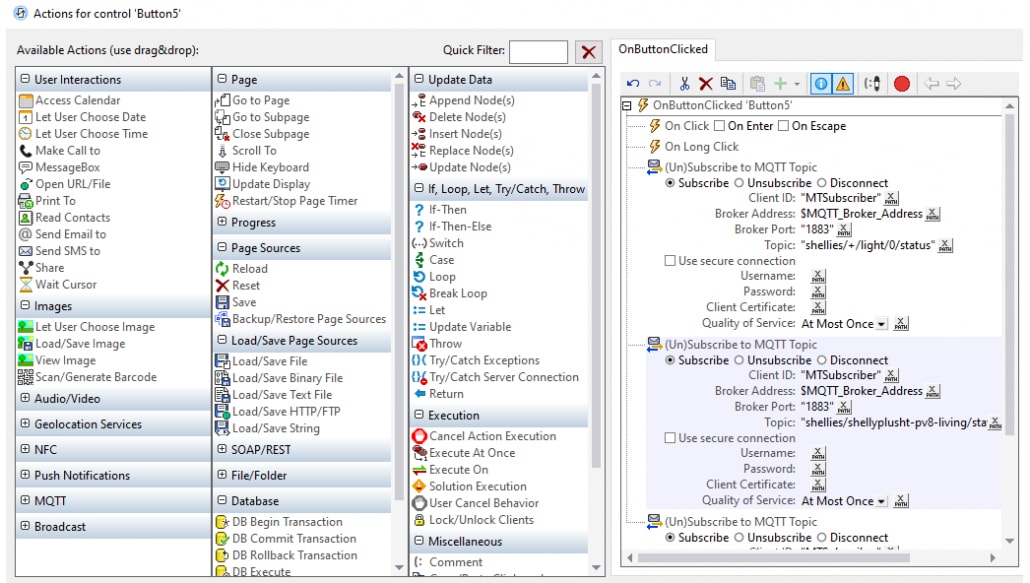Build an MQTT-enabled App
As IoT adoption continues, smart devices are driving efficient automation in our homes, in offices, and at scale in myriad industrial applications. Communication protocols play an increasingly pivotal role in ensuring seamless connectivity between devices used in these scenarios. One such protocol that has gained widespread adoption for its efficiency and lightweight nature is MQTT.
MQTT’s flexibility allows app developers to implement it in various scenarios, from small-scale projects to enterprise-level applications. Whether it’s a simple office automation system or a complex industrial network, MQTT provides reliable, efficient communication between smart devices in real time.
Altova MobileTogether includes comprehensive support for building MQTT-enabled apps for iOS, Android, and Windows devices. Its low-code, RMAD approach to cross-platform app development gets those apps out the door in record time.
Let’s see how it works.

MQTT Messaging Protocol
An OASIS standard messaging protocol, MQTT (Message Queuing Telemetry Transport) enables device-to-device telemetry in scenarios where low bandwidth, high latency, or an unreliable network connection is prevalent. This lightweight protocol has a publish/subscribe architecture designed for reliable communication among devices, making it ideal for IoT scenarios.
MQTT’s decentralized model of communication allows devices to publish information to a central broker and subscribe to topics of interest. The broker filters messages based on their topic. Clients subscribe to one or more topics and receive the corresponding messages from the broker. Clients can both publish and subscribe to topics.

Its lightweight nature ensures minimal bandwidth usage and low latency, making MQTT a good choice for resource-constrained environments, such as those running IoT devices with limited processing power and bandwidth. At the same time, MQTT is highly scalable and can support connections among millions of smart devices.
MQTT is used in scenarios including smart home, smart office, and smart city systems. Today, the protocol is especially critical in industrial automation.
Automating Industrial IoT
Industrial IoT (IIOT) applications using MQTT for communication between smart devices are wide ranging across verticals from manufacturing to healthcare to oil and gas and beyond. For instance, in a smart factory utilizing MQTT, sensors on the production line publish real-time data on machine status and quality metrics to a central broker. Utilizing an app that subscribes to these topics allows plant managers to make instant decisions, optimize processes, and enhance overall efficiency.
Here are some common benefits of using MQTT in industrial automation:
Efficient and Lightweight Communication
IIoT environments often involve numerous sensors, actuators, and devices dispersed across industrial facilities. The lightweight nature and minimal overhead of the MQTT protocol are helpful for optimizing data transfer in large-scale industrial deployments.
Real-Time Monitoring, Alerts, and Control
MQTT’s publish/subscribe model enables real-time monitoring and control of industrial processes. IIoT applications built on MQTT can transmit important data, such as sensor readings and equipment status, in real time. This allows prompt decision-making and responsive control over industrial systems.
Scalability for Large-Scale Deployments
MQTT’s scalability makes it well-suited for handling large-scale deployments, ensuring that communication remains efficient as the number of connected devices increases.
Machine-to-Machine (M2M) Communication
IIoT relies heavily on M2M communication, where machines and devices need to exchange data autonomously. MQTT’s asynchronous communication model supports M2M communication, allowing devices to publish information and others to subscribe for updates, promoting interoperability.
Remote Monitoring and Maintenance
Using MQTT makes remote monitoring and maintenance of industrial equipment easier. Maintenance teams can receive real-time updates on equipment status, perform diagnostics, and even initiate remote actions, reducing downtime and improving overall efficiency.
Energy Efficiency
The protocol’s lightweight nature contributes to energy efficiency in industrial IoT deployments. Devices can transmit data with minimal energy consumption, making it ideal for battery-powered sensors and devices commonly found in industrial settings.
Interoperability and Standardization
Using a standards-based protocol ensures interoperability among different devices and systems. This standardization simplifies integration efforts and allows devices from different manufacturers to communicate.
Of course, these benefits apply equally to scenarios outside industry such as smart office and smart city systems.
What organizations need are easy-to-use client applications for managing and monitoring automation facilitated through MQTT. That’s where Altova MobileTogether comes in.
How to Build MQTT-enabled Apps
Altova MobileTogether is a low-code, highly affordable solution for building MQTT-enabled apps for monitoring and managing communications among smart devices. Whether you need to build a dashboard for remote monitoring or a client for real-time operations management, MobileTogether can get your MQTT solution out the door in record time.
With MobileTogether, you build once to generate apps for iOS, Android, and Windows devices as well as an HTML5 browser-based client (write once, deploy everywhere).
Take a look at a quick example of an app we created to demonstrate this functionality in a smart home automation scenario:
MQTT support in MobileTogether allows apps to join an MQTT network as a publisher, a subscriber, or both.
The development environment uses a combination of drag-and-drop UI design, the powerful Action Tree visual programming language for event handling, and standardized functional programming for data selection and processing. This unique, low-code approach makes it easy to define and test the various aspects of an MQTT-enabled app:
- Set up a solution that can subscribe and unsubscribe to topics, publish messages, and disconnect from a broker
- Integrate rich charts, graphs, and dashboards
- Specify the actions to perform when the solution receives an MQTT message
- Set up an MQTT service
- Simulate and debug app behavior during development using recorded, real-world input

The comprehensive and easy-to-implement MQTT support in MobileTogether gives developers the flexibility to build a wide range of apps for industrial automation and other smart device systems.
It’s easy to get started building your first MQTT-enabled app in MobileTogether, which includes comprehensive documentation on MQTT app development in the Help file accessible when you download the free MobileTogether Designer.
